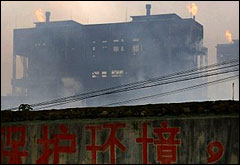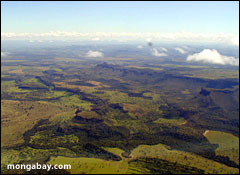In what surely counts as one of the greatest feats in the history of global trade, the United States has essentially outsourced its manufacturing base to China in little more than a decade.

It all starts with shuttered factories.
Photo: iStockphoto
But in doing so, the U.S. has helped unleash new trends in global agriculture that threaten global climate stability and biodiversity. In short, China is rapidly plunking down factories and apartment buildings on prime farmland, and polluting much of what remains with industrial runoff.
To feed its rapidly urbanizing and meat-hungry population, China is in turn outsourcing its agricultural production to Brazil, particularly soybeans for livestock feed. In response, Brazil is plowing up its vast savanna (and even rainforest) lands to plant soy, negating vitally important natural sponges for global carbon emissions and swallowing habitat in one of the world’s richest stores of plant and animal life.
Great Leap Forward?
As recently as 1996, the U.S. imported a modest $51.5 billion in goods from China, and ran a trade deficit of $39.5 billion. Last year, U.S. demand sucked in $287.8 billion in Chinese goods, and our trade deficit gaped to $232.5 billion.
Meanwhile, the U.S. manufacturing base has withered. American companies have been shuttering factories and laying off workers for decades, but those trends accelerated in the late 1990s. According to the Congressional Budget Office, U.S. manufacturing jobs plunged by nearly 20 percent between 1999 and 2004, and stand at their lowest level since the late 1950s.
The rolling up of our manufacturing base has done little to mitigate growth in domestic energy use, which continues to rise steadily. But China’s manufacturing boom has caused its own use of the dirtiest fossil fuels, coal and petroleum, to spike. Lester Brown of the Earth Policy Institute reports that China’s petroleum consumption doubled between 1994 and 2004; the country now trails only the U.S. as the world’s most profligate oil user. According to the Financial Times, China expects its oil use to double from current levels within five years.

You can hear Wal-Mart’s prices falling all the way from China.
As for coal, The New York Times reported last year that China already consumes more than the U.S., Japan, and the European Union combined. The Times added — chillingly for anyone who understands the true horror of coal use — that China has “increased coal consumption 14 percent in each of the past two years.” Moreover, as oil prices rise, China is investing heavily in technologies to convert coal into liquid car fuel.
Thus China’s industrial boom has obvious — and dire — consequences for climate change. What does it mean for global agriculture? For one thing, China’s voracious demand has helped ratchet up oil prices over the last five years, and high oil prices have sparked a global rush to transform food crops into fuel. The U.S. government has hotly promoted this trend, inspiring record plantings of corn, our most environmentally destructive crop.
More directly, as China’s industrial footprint grows, its farmland shrinks. About a year ago, the Chinese government revealed that the nation had surrendered about 8 million hectares of farmland over the previous decade — 6.6 percent of its arable land, and about two-thirds the amount of land that’s under cultivation in Iowa.
Industrial pollution has taken out another similar-sized chunk of China’s farmland. On Monday, the government acknowledged that 10 million hectares had been “ruined” by build-up of heavy metals, mainly from coal-fired factories.
Plowing Up a ‘Wasteland’
As its population grows and its farmland disappears, China is also scrambling to meet demands for a more Western-style — i.e., meat-heavy — diet among its population. That means industrial-style meat production — and mountains of soybeans and grain for feed.
Thus China is increasingly looking to Brazil for sustenance. New York Times agriculture reporter Alexei Barrionuevo reported last week that Brazil’s soy shipments to China are growing exponentially. “Last year Brazil sent nearly 11 million tons of beans to China, a 50 percent increase from the previous year and nearly double the amount shipped in 2004,” he writes.
Brazil’s soy boom, driven also by European demand, has already cut deeply into the Amazon rainforest, probably the world’s most important natural sink for carbon emissions, as well as a vital store of biodiversity. However, much of that deforestation is illegal, and the Brazilian government has vowed to enforce bans on more soy plantations. Just last month, the government finally shut down a major soy plant located at the mouth of the Amazon owned by U.S. agribusiness giant Cargill. That move, if it holds, should greatly decrease incentives to illegally farm soy in the rainforest.

Brazil’s Cerrado is being plowed under to meet growing appetites.
Photo: Sue Wren
But development of the Cerrado region, a vast savanna that borders the rainforest, continues apace. Until the 1960s, when the government began converting the Cerrado into farmland, global agribusiness interests viewed the area as an “inaccessible wasteland” [PDF].
Yet the Cerrado is home to the Xavante Wará, an indigenous group that has been under severe pressure from powerful soy interests. And like its more famous geographical neighbor, the Cerrado contains multitudes of rare wildlife and vegetation. According to a 2005 issue of Nature, the region provides habitat for 137 endangered species, “and the sparse, scrubby vegetation features more than 4,000 species that grow only here.” The Nature Conservancy calls it “the world’s most biologically rich savanna.”
Unlike the rainforest, the Cerrado draws little legal protection. “Over the past 35 years, more than half of the Cerrado’s original expanse of 2 million square kilometers has been taken for agriculture,” reported Nature, adding that, if present trends continued, the ecosystem would be gone by 2030.
Turning the Cerrado into China’s (and Europe’s) soy patch requires copious lashings of synthetic fertilizers. The region’s soils support a dramatic array of native plants, but they don’t work so well for monocropped soy. Thus Brazil’s soy miracle has been built on a cascade of outside inputs — typically supplied, Barrionuevo reports, by the same agribusiness giants who buy most of the soy, companies like Cargill, Archer Daniels Midland, and Bunge.
Thus, to go back to the beginning of our story, our insatiable appetite for cheap goods from Wal-Mart and other big-box retailers comes at a steep price. We can’t stop China from devouring and fouling its farmland, or unleashing vast stores of carbon by burning through oil and coal. Nor can we stop Brazilians from ripping into indigenous homelands and precious stores of biodiversity (though it should be noted that many U.S. citizens have participated in the Cerrado land grab).
But we can demand that the U.S. government stop using supranational institutions like the International Monetary Fund, the World Bank, and the WTO to supercharge cross-border trade and capital flows. And we can also, as consumers, opt out as much as possible from the Wal-Martization of everything, and work to rebuild local economies.


